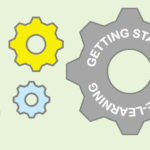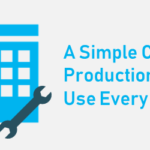Great post, Tom. I like what you said about pushing vs. pulling information. I’ve been trying to change some of my own training efforts to more of a “coursels” style, so it’s good to know I’m not out in left field by myself.
Here’s Why Slide Count is Irrelevant to Your E-Learning Course
November 1st, 2011
I get a lot of questions about number of slides or screen count per hour of instruction. My answer is that screen count is usually irrelevant. Let me explain.
First, to the elearner screen count means nothing. For example, I can make ten points on a single screen or have ten screens, each with a single point. The time it takes to get through each point may be the same. More screens don’t make it longer and fewer screens don’t make it shorter.

Screen count becomes even more irrelevant when you introduce interactive elements like branched navigation which could be made up of dozens of screens. The time it takes to go through them depends on how fast the person can review the content and make decisions (and then react to feedback).
Ask the Right Question
Screen count is the wrong question. People typically ask the question because they are tasked to build an hour of learning and want a better sense of how much content creation that means.
Instead of asking about screen count (which is driven more by dumping information) focus on how to create meaningful elearning that will make the hour more productive for the learner. In the long run it costs less and will save time.
Following are some simple tips to help build more productive elearning.
Don’t Auto-Advance Slides
Screens have information. Adding text or narration to them isn’t a problem. Not every screen is going to be interactive. With that said, how the user controls the information is something to consider. Many developers will lock the screen and set it to auto advance. The problem with this is that if the person is a fast reader, it’s frustrating to wait for the slide to catch up. If the person is a slow reader, they won’t get everything they need before the slide advances.

Screens that have text and no audio should advance based on the viewer’s reading speed. The length of time on the slide is determined by how fast the person can read (or interact with the screen) and not by some arbitrary average reading speed.
The same can be said for slides with narration. Ideally, the screen text and slide narration aren’t verbatim. But if you have narration and text, it’s a good idea to let the learner choose when to advance. I usually just set it to advance by user. When they’re ready they can go to the next screen.
I’ll also add that if they have to read a lot on the screens, then they’re probably going to fall asleep during the course. So you’ll want to do something to jar them awake.
Give the Learner Control
Even though they’re looking at the same screen, people will focus on different things. Some are really fast and will quickly scan the screen looking for visual cues. Others are more deliberate. Many lose track during the session and will want to pause and restart the content at various points.

If you really want them to learn, then give them the freedom to navigate the content as they need to. One of the great benefits of elearning is that it’s asynchronous. Take advantage of this. Free up the course navigation. Let them explore.
“But I can’t do that, my customer wants to be sure they see all of the content!”
We’ll address that below.
Build Productive E-Learning
How many slides per hour is the wrong focus. It’s better to consider how to create the best course given a certain time limit. Here are three simple tips:
Break the content into bite-size chunks. Regardless of how you design the course, people can only digest so much information. Instead of an hour long course, you may consider 5 ten-minute courses where you can tackle smaller topics that are easier to process.

I like to call these coursels (as in course morsels). They’re small, bite-size chunks of the course content. Give them some information and then a quick way for them to apply it. Then space it over time. Spacing the information over a period of time will help them retain what they’re learning.
- Previous post: Ignore This Post If You Don’t Care About Effective Learning
Are you viewing or doing? Some courses are only about sharing information. In fact, they’re probably not really elearning. I like to think of them more as multimedia ebooks. The goal is to share information that is of interest or use to the learner, but not necessarily tied to performance goals.

In those cases, it’s all about efficiently creating and sharing the information. It’s also a good idea to link the information to other performance support outside of the course. This way you get the most value out of it.
If you do have performance expectations, then you want to turn the focus from the information to one that is learner-centric.
- Previous post: Want to Build Better E-Learning Courses? Think Beer
Are you pushing or pulling? Info-centric courses push content out to the learner. The focus is not on performance. Instead it’s on how much information can be pushed out. Hence the questions about slide count. “How much content can I push out in an hour?”
Wikipedia has more than 10,000 pages of information. If I asked you a question and let you search Wikipedia for an answer, odds are that you won’t need all 10,000 pages. You’ll only need what you need to answer the question. Based on how I ask it or what I do to follow up your answers, I can get you to research and review all sorts of content.
The same applies to elearning. We can create a course that has all sorts of information and content available to the learner. But people aren’t successful because they have information. They’re successful because they know how to use it.

Create pull interactions where the learner has to make decisions. And if they don’t know what to do, provide a way for them to pull the information they need. If they’re new to the topic, they’ll need more supporting information. But a more experienced person may need less. Thus, there’s a lot of info
rmation (or screens of content) but the number of screens is not relevant to completing the course. What’s relevant is that they can make the right decisions.
- Previous post: Are Your E-Learning Courses Pushed or Pulled?
Building good elearning is more than just providing information. The key is figuring out how they’ll use the information. And then create ways for them to make decisions using the information. How you structure the decision-making and tap into the learner’s motivation is where the course is productive.
With all that said, if all you want to do is push out some screens of content, then 30 screens per hour is a good figure. How many screens per hour do you recommend? You can share your thoughts by clicking on the comments link.
Events
- Everyday. Check out the weekly training webinars to learn more about Rise, Storyline, and instructional design.
Free E-Learning Resources
 |
 |
 |
|
Want to learn more? Check out these articles and free resources in the community. |
Here’s a great job board for e-learning, instructional design, and training jobs |
Participate in the weekly e-learning challenges to sharpen your skills |
 |
 |
 |
|
Get your free PowerPoint templates and free graphics & stock images. |
Lots of cool e-learning examples to check out and find inspiration. |
Getting Started? This e-learning 101 series and the free e-books will help. |
27 responses to “Here’s Why Slide Count is Irrelevant to Your E-Learning Course”
[…] Follow this link: Here’s Why Slide Count is Irrelevant to Your E-Learning Course » The Rapid eLearning Blog […]
Excellent blog post. I agree w/your assessment that slide count is irrelevant in an E-Learning course. I wonder if irrelevancy also applies to number of clicks faculty (or students) have to make in order to “prove” teacher or student presence in a course. I am looking for research that would show this to be the case. Have you come up with any data that make a causal relationship between recorded “clicks” and teacher presence? Any info you (or others) can send my way would be greatly appreciated! Thanks again for your great blog posts. I enjoy reading them and we’re retwitting them on and off via our Center for Teaching and Learning Twitter page. 🙂
Thanks for all the great content that you make available to us Tom. I have been reading your blog and spending time with all the great screen casts that you and the other folks at Articulate have put together. I really appreciate the topics you cover and the advice you give out. As a new Articulate user and someone relatively new to elearning I am trying to learn all I can so that I create effective training/learning modules. I could not do it without all of your help. Keep up the great work!
Sorry, this article misses the point. Word slides are horribly boring and a very poor way to convey information, whether or not you spread words across multiple slides, twirl them into place, use jingles or dazzle with animation.
Tom says, “Ideally, the screen text and slide narration aren’t verbatim”, but don’t read (no pun intended) too much into that. Allow me to explain. And this is from a presentation perspective, but is applicable to eLearning.
We all know how goofy a speaker is when he reads his slides, so most speakers try to avoid it. But the mind has trouble simultaneous reading and listening to two different streams of verbiage. Ironically, comprehension is better when the speaker actually does read his slides, but then we’re back to goofy. So at that point, the speaker may as well have stayed home and emailed his slides to everyone. But as Tom points out, reading slides is apt to put the audience, or learner, to sleep.
Instead, keep the verbiage with the speaker (narrator) and remove the text from the screen. Then use that open slate for images and graphics. The mind is perfectly capable of simultaneously processing spoken words and non-text visuals. That’s why TV, movies and YouTube are so popular. So now the screen [visuals] and slide narration aren’t verbatim.
OK, a few words are accptable. But no more than you can count on one hand. And at that point, those bullet points are no longer necessary.
Hi Tom, great post as usual!
I think any focus on the length of a course detracts from meeting the learning objectives. Why pad e-learning out to an hour, or even half an hour, if you can meet the learning objectives in 10 or 20 minutes? All that extra 40 or 50 minutes is just going to make the learner question why they’re spending their time on the course and look at what they’re getting out of that time – which is probably going to lead to others higher up the food chain questioning why they’re investing in e-learning in the first place. Not a good result for anyone!
Great post and my three cheers for an excellent point. Firstly, when it comes to eLearning we have to stop thinking in terms of ‘slides’ – apart from anything else I could have a learn that views 30 slides and another 50 slides within the same course.
This could be because one selects a ‘more info please’ link on every slide or because they do activities that takes them through different pathways of the course (push & pull style).
I also do a lot of ‘build slides’ and to the participant 10 ‘build slides’ appears as one screen.
I also find I get asked this question when building ppt for presentations. I once had a colleague who was shocked that I had 50 slides in a short presentation – but I had very little text, lots of graphics.
I also had hidden links within the slide so that if the audience wanted more information I could jump to a relevant ‘hidden’ slide that wasn’t part of a more linear style presentation.
He was so conditioned to expecting a ppt presentation to consist of slides with six bullet points and maybe the odd graphic that it never occured to him that a presentation could be done any other way.
I think this is why so many so-called eLearning ‘experts’ are so dismissive of rapid eLearning tools such as Captivate and Articulate (and for that matter PowerPoint).
In a recent LinkedIn group, one commenter dismissed Articulate as ‘PowerPoint with bling’. Yet – I find those with this attitude are far more wrapped up in what the tool can do rather than what the learning can do.
I think the far better discussion is how many learning chunks within your course is ideal? What aids learning and retention of learning?
I say ‘down with slide mentality’. Let’s get back to focussing on the important stuff – building meaningful and practical learning.
@Jim Janossey
“Sorry, this article misses the point. Word slides are horribly boring and a very poor way to convey information, whether or not you spread words across multiple slides, twirl them into place, use jingles or dazzle with animation.”
Not sure what you’re saying here:) I’ll agree that words “can” be horribly boring. They “can” be a very poor way to convey information. However, words can also be an excellent way to convey information when chosen and composed well.
In many, possibly most, cases text is a relevant and effective graphical / visual element. Sometimes text is the best way to convey information. Sometimes it’s not the best way, but a trade-off must be made based on resources.
I think the example you referenced above was used to illustrate the point that slide count is irrelevant as a metric for seat time. For the purpose of the article, I don’t think this is off the mark at all. The stuff that matters… matters. The stuff that works… works. Generalizations… are generalizations.
A world without words would be mighty silent and bleak.
@Jennifer
Agree completely with “down with the slide mentality”. Slides are one mechanism of many that can be used to organize and carry an experience. We’ve really gotten bogged down in slide-centric dogma in the eLearning world, haven’t we? 🙂
The article reinforces what I’ve been arguing about with my Customers. Some, particularly bean-counters, think training needs to be ugly and painful. They’ve gone so far as to buy an Articulate license and are distibuting the most horrible stuff imaginable!
I try to make interesting and engaging content and spend half my time arguing about why the location of the advance control is irrelevant, or why the slide count is irrelevant, and so on.
What can you do with these knuckle-draggers?
Thank you for sharing this vital information. I am finishing up my grad studies at Roosevelt University and am embarking into e-learning on my job. I too have been challenged with determining how much content to put on a screen when converting ILT courses to e-learning. I am beginning to see that I need to change my mindset from just dumping my powerpoints to e-learning screens in order to have an e-learning alternative. My focus needs to be on the type of on-line learning experience I want my participants to have.
I like the concepts of “push” vs. “pull” content you presented. Push content allows adult learners to have more control over their learning and gives them the opportunity to delve into the material they need at the time. This approach would be very useful for our company knowledge or how-to courses.
Thank you for sharing this vital information. I am finishing up my grad studies at Roosevelt University and am embarking into e-learning on my job. I too have been challenged with determining how much content to put on a screen when converting ILT courses to e-learning. I am beginning to see that I need to change my mindset from just dumping my powerpoints to e-learning screens in order to have an e-learning alternative. My focus needs to be on the type of on-line learning experience I want my participants to have.
I like the concepts of “push” vs. “pull” content you presented. Push content allows adult learners to have more control over their learning and gives them the opportunity to delve into the material they need at the time. This approach would be very useful for our company knowledge or how-to courses.
Thanks for the great blog
next time can we also argue that the length of course is as irrelevant as slide count and that what really matters is behavioural outcomes which can be observed and measured.
On a theoretical basis I agree on all points: performance must be the goal. But in the real world companies pay their employees by hour, so they want to know how many hours of “productivity time” the course corresponds to…how do you calculate it?
[…] Here’s Why Slide Count is Irrelevant to Your E-Learning Course […]
[…] View the article. […]
@Alberto – There are a few ways to calculate the average time that will be spent in an experience. The best way is through user testing and evaluation over time. Estimates are rarely validated. Sometimes they are right on… But if a tree falls in the forest and no one is there to record it… You know?
One way to get a rough estimate ahead of course deployment, one which I recommend if you’re targeting an outside limit, is to estimate each component of the experience.
One element is your messaging. Messaging consists of narration, reading assignments, infographics, etc.. Some messaging is easy to estimate (there are word count estimators out there for narration and written word).
http://community.articulate.com/forums/p/3063/16363.aspx#16363
Another element includes application / activities. You can estimate these as well since they likely contain messaging elements. During the process of design you’re also making assumptions about the amount of time your audience will need to grasp the concept, the amount of time they’ll probably need to practice to reach mastery, etc.. These assumptions go into your time estimate. Assuming that you’re validating your assumptions and making adjustments as you gain insight through testing, your estimates should be pretty close.
Screen count is one of the weaker methods you can use to calculate outcomes and measures of time requirements. In my opinion, this is an unhealthy way to frame up a solution. It encourages the creation of buckets on a conveyor. It’s convenient for estimation. But it’s not precise and in all likelyhood it will spoil your solution.
Great post. Love the humor. The kid reminds me of home alone.
Thanks Tom for a great article. I liked reading through it, and I agree with you on the idea that slides count does not affect the learning. However, it is the method we present information and the learning styles we took into consideration when planning and presenting the information. The main target of a presentation is to be able to deliver it to as many learners as we can.
The theory of multimedia learning deals with this issue. The theory is built on the philosophy that “the design of e-learning courses should be based on cognitive theory of how people learn and on scientifically valid research studies. In other words, e-learning courses should be constructed in light of how the mind learns and experimental evidence concerning e-learning features that promote best learning. (R.E. Mayor)
This theory proposes three main assumptions: (R.E. Mayor)
1- There here are two separate channels (auditory and visual) for processing information (Dual-Coding theory)
2- Each channel has a limited (finite) capacity
3- Learning is an active process of filtering, selecting, organizing, and integrating information based upon prior knowledge.
When preparing a presentation, we consider ourselves as learners. How do we learn better? What components should we include, in the presentation, to aid better learning? How can we grab the attention of the learners, so we keep them concentrated on the information or skills we want to deliver to them? One more question: how can we make the learners enjoy what they learn? The answers of these questions will help make a better presentation that successfully delivers what we want to give our learners. The experience we have in learning, in addition to teaching, will help us design a presentation that better meets the needs of different learners.
Reference:
http://www.learning-theories.com/cognitive-theory-of-multimedia-learning-mayer.html
http://sites.wiki.ubc.ca/etec510/Cognitive_Theory_of_Multimedia_Learning
In our organization I constantly battle the information dump. Even some learners are taken aback when an activity is introduced before the course content in order for the learner to demonstrate whether they know the topic or if they know where to look for the information to solve the problem presented. It is surprising to me that in almost 2012 we are still trying to force feed information into learner’s heads!
[…] […]
WOW just what I was searching for. Came here by searching
for investing
Thanks for every other wonderful article. The place else
may just anybody get that kind of information in such an ideal manner of
writing? I’ve a presentation next week, and I am at the look for such information.









0
comments